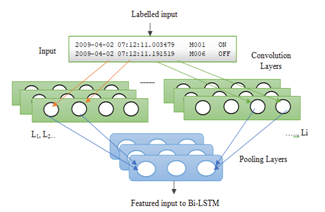An Imperceptible Method to Monitor Human Activity by Using Sensor Data with CNN and Bi-directional LSTM
Main Article Content
Abstract
Deep learning (DL) algorithms have substantially increased research in recognizing day-to-day human activities All methods for recognizing human activities that are found through DL methods will only be useful if they work better in real-time applications. Activities of elderly people need to be monitored to detect any abnormalities in their health and to suggest healthy life style based on their day to day activities. Most of the existing approaches used videos, static photographs for recognizing the activities. Those methods make the individual to feel anxious that they are being monitored. To address this limitation we utilized the cognitive outcomes of DL algorithms and used sensor data as input to the proposed model which is collected from smart home dataset for recognizing elderly people activity, without any interference in their privacy. At early stages human activities the input for human activity recognition by DL models are done using single sensor data which are static and lack in recognizing dynamic and multi sensor data. We propose a DL architecture based on the blend of deep Convolutional Neural Network (CNN) and Bi-directional Long Short-Term Memory (Bi-LSTM) in this research which replaces human intervention by automatically extracting features from multifunctional sensing devices to reliably recognize the activities. During the entire investigation process we utilized Tulum, a benchmark dataset that contains the logs of sensor data. We exhibit that our methodology outperforms by marking its accuracy as 98.76% and F1 score as 0.98.
Article Details
References
Ahmad, Taati, and Alex Mihailidis, “Autonomous unobtrusive detection of mild cognitive impairment in older adults,” IEEE Transactions. Biomed. Eng., vol. 62, no. 5, 2015,pp. 1383–1394.
U. S. C. Euro monitor International, “Living alone statistics,” 2015.[Online]. Available: http://www.statisticbrain.com/living-alone-statistics/
M. Gochoo, “Device-free non-privacy invasive activity monitoring of elderly people in a smart house,” Ph.D. dissertation, Dept. Electr. Eng., Nat.Taipei Univ. Technol., Taipei, Taiwan, 2017,
WSU CASAS smart home project. D. Cook. “Learning setting-generalized activity models for smart spaces”. IEEE Intelligent Systems, 2011
Chen, Nugent, H. Wang, “A knowledge-driven approach for activity recognition in smart homes based on activity profiling”. Future Gener. Comput. Syst. 10, vol.6, 2020,pp 924–941. https://doi.org/10.1016/j10.031
Chunyu, Chen, Lisha and Xiaohui Peng “A novel random forests based class incremental learning method for activity recognition” Pattern Recog.2018,vol 78,pp2 77–290. DOI.org/10.1016/j.patcog.2018.01.025.
M. S. Hossain, “Patient state recognition system for healthcare using speech and facial expressions,” J. Med. System, vol. 40, no. 12,2016 p. 272.
Zhang, and Karunanithi.M," Assessment of activities of daily living Via a smart home environment”, Quantifying Quality of Life. Health Informatics. Springer, Cham. 2022,vol 8,pp342-358,https://doi.org/10.1007/978-3-030-94212-0_20
Natani, Sharma and Perumal, T. "Sequential neural networks for multi-resident activity recognition in ambient sensing smart homes". Applied Intelligence, vol 51, pp.6014–6028 (2021). https://doi.org/10.1007/s10489-020-02134-z
C. Hu,Chen,Peng,Yu, C. Gao and Lisha, "A novel feature incremental learning method for sensor-based activity recognition," in IEEE Transactions on Knowledge and Data Engineering, vol. 31, no. 6, pp. 1038-1050, 2019, DOIi: 10.1109/TKDE.2018.2855159.
Jurek, Nugent, Bi Y, Wu. "Clustering-based ensemble learning for activity recognition in smart homes". Sensors, 2014 Jul 10; vol.4 (7):12, pp285-304. DOI: 10.3390/s140712285. PMID: 25014095.
Wang, Jindong, Vincent Wenchen Zheng, Yiqiang Chen and Meiyu Huang. “Deep transfer learning for cross-domain activity recognition.” ICCSE'18 (2018).
Rashidi, Cook DJ, Holder, Schmitter-Edgecombe,"Discovering activities to recognize and track in a smart environment". IEEE Transaction, Knowledge Data Engineering. 2011; vol.23 (4):pp527-539. DOI: 10.1109/TKDE.2010.148.
Baghezza, Bouchard, Bouzouane, Vallerand C. "From offline to real-time distributed activity recognition in wireless sensor networks for healthcare: A Review". Sensors. 2021; vol.21 (8):pp2786-2798. https://doi.org/10.3390/s21082786
Shah, Malik, Khatoon et al. "Human behavior classification using geometrical features of skeleton and Support Vector Machines. Computers, Materials & Continuation, 2018, vol 58. Pp535-553. Doi:10.32604/cmc.2019.07948.
Hao, Bouzouane, Gaboury, “Recognizing multi-resident activities in non-intrusive sensor-based smart homes by formal concept analysis”. Neuro computing 2018, vol 318, pp75–89, https://doi.org/10.1016/j.neucom.2018.08.033.
Alemdar, Ersoy “Multi-resident activity tracking and recognition in smart environments”. J. Ambient Intelligence and Humanized Computing. 2017, vol.8, pp513–529.
Xiong et al “Activity feature solving based on TF-IDF for activity recognition in smart homes”. Complexity 2019, https://doi.org/10.1155/2019/5245373
Bigham et al “Real-time crowd labelling for deployable activity recognition,'' in Proceedings of Conf. Computing Supported Cooperation, 2013, pp. 1203_1212
S. Zhang et al., "Cough trigger: Ear buds IMU based cough detection activator using an energy-efficient sensitivity-prioritized time series classifier," ICASSP 2022 IEEE Intl. Conf. on Acoustics, Speech and Sigl Proc. (ICASSP),pp. 1-5, DOI: 10.1109/ICASSP43922.2022.9746334.
Grais, Wierstorf, Ward, Plumbley, "Multi-Resolution fully convolutional neural networks for monaural audio source separation". LVA/ICA 2018. Lecture Notes in Comp. Sci, vol 10891. Springer, Cham. https://doi.org/10.1007/978-3-319-93764-9_32

